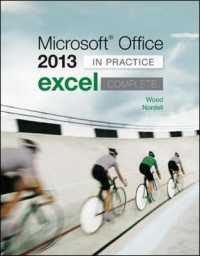- ホーム
- > 洋書
- > 英文書
- > Science / Mathematics
Full Description
A reliable and focused treatment of the emergent technology of fifth generation (5G) networks
This book provides an understanding of the most recent developments in 5G, from both theoretical and industrial perspectives. It identifies and discusses technical challenges and recent results related to improving capacity and spectral efficiency on the radio interface side, and operations management on the core network side. It covers both existing network technologies and those currently in development in three major areas of 5G: spectrum extension, spatial spectrum utilization, and core network and network topology management. It explores new spectrum opportunities; the capability of radio access technology; and the operation of network infrastructure and heterogeneous QoE provisioning.
5G Networks: Fundamental Requirements, Enabling Technologies, and Operations Management is split into five sections: Physical Layer for 5G Radio Interface Technologies; Radio Access Technology for 5G Networks; 5G Network Interworking and Core Network Advancements; Vertical 5G Applications; and R&D and 5G Standardization. It starts by introducing emerging technologies in 5G software, hardware, and management aspects before moving on to cover waveform design for 5G and beyond; code design for multi-user MIMO; network slicing for 5G networks; machine type communication in the 5G era; provisioning unlicensed LAA interface for smart grid applications; moving toward all-IT 5G end-to-end infrastructure; and more. This valuable resource:
Provides a comprehensive reference for all layers of 5G networks
Focuses on fundamental issues in an easy language that is understandable by a wide audience
Includes both beginner and advanced examples at the end of each section
Features sections on major open research challenges
5G Networks: Fundamental Requirements, Enabling Technologies, and Operations Management is an excellent book for graduate students, academic researchers, and industry professionals, involved in 5G technology.
Contents
Foreword xxi
Preface xxv
Author Bios xxvii
List of Contributors xxxi
List of Abbreviations xxxvii
Introduction 1
Part I Physical Layer for 5G Radio Interface Technologies 13
1 Emerging Technologies in Software, Hardware, and Management Aspects Toward the 5G Era: Trends and Challenges 15
Ioannis-Prodromos Belikaidis, Andreas Georgakopoulos, Evangelos Kosmatos, Stavroula Vassaki, Orestis-Andreas Liakopoulos, Vassilis Foteinos, Panagiotis Vlacheas, and Panagiotis Demestichas
1.1 Introduction 15
1.2 5G Requirements and Technology Trends 17
1.3 Status and Challenges in Hardware and Software Development 20
1.4 5G Network Management Aspects Enhanced with Machine Learning 38
1.5 Conclusion 45
References 45
2 Waveform Design for 5G and Beyond 51
Ali Fatih Demir, Mohamed Elkourdi,Mostafa Ibrahim, and Huseyin Arslan
2.1 Introduction 51
2.2 Fundamentals of the 5G Waveform Design 52
2.3 Major Waveform Candidates for 5G and Beyond 58
2.4 Summary 70
2.5 Conclusions 73
References 73
3 Full-Duplex System Design for 5G Access 77
Shu-ping Yeh, Jingwen Bai, PingWang, Feng Xue, Yang-seok Choi, Shilpa Talwar, Sung-en Chiu, and Vinod Kristem
3.1 Introduction 77
3.2 Self-Interference Cancellation 79
3.3 FD System Design: Opportunities and Challenges 82
3.4 Designing the FD System 84
3.5 System-Level Performance Analysis 108
3.6 Conclusions and Future Directions 125
References 130
4 Nonorthogonal Multiple Access for 5G 135
Linglong Dai, Bichai Wang, Ruicheng Jiao, Zhiguo Ding, Shuangfeng Han, and Chih-Lin I
4.1 Introduction 135
4.2 Basic Principles and Advantages of NOMA 137
4.3 Power-Domain NOMA 142
4.4 Code-Domain NOMA 155
4.5 Other NOMA Schemes 170
4.6 Comparison and Trade-Off Analysis of NOMA Solutions 178
4.7 Performance Evaluations and Transmission Experiments of NOMA 181
4.8 Opportunities and Future Research Trends 185
4.9 Conclusions 189
References 189
5 Code Design for Multiuser MIMO 205
Guanghui Song, Yuhao Chi, Kui Cai, Ying Li, and Jun Cheng
5.1 Introduction 206
5.2 Multiuser Repetition-Aided IRA Coding Scheme 207
5.3 Iterative Decoding and EXIT Analysis 209
5.4 Code Optimization Procedure 217
5.5 Numerical Results and Comparisons 218
5.6 Conclusion 230
References 231
6 Physical Layer Techniques for 5G Wireless Security 237
Batu K. Chalise, Himal A. Suraweera, Gan Zheng, and Risto Wichman
6.1 Introduction 237
6.2 5G Physical Layer Architecture 241
6.3 Secure Full-Duplex Receiver Jamming 247
6.4 Secure Full-Duplex Bidirectional Communications 255
6.5 Secure Full-Duplex Relay Communications 259
6.6 Future Directions and Open Issues 266
6.7 Conclusion 268
References 269
7 Codebook-Based Beamforming Protocols for 5G Millimeter Wave Communications 275
Anggrit Dewangkara Yudha Pinangkis, Kishor Chandra, and R. Venkatesha Prasad
7.1 Introduction 275
7.2 Beamforming Architecture 278
7.3 Beam Searching Algorithm 280
7.4 Codebook Design 286
7.5 Beamforming Evaluation 290
7.6 Conclusion 291
References 293
Part II Radio Access Technology for 5G Networks 299
8 Universal Access in 5G Networks: Potential Challenges and Opportunities for Urban and Rural Environments 301
Syed Ali Hassan, Muhammad Shahmeer Omar,Muhammad Ali Imran, Junaid Qadir, and Dushantha Nalin K. Jayakody
8.1 Introduction 301
8.2 Access for Urban Environments 302
8.3 Providing Access to Rural Areas 312
8.4 Conclusions 320
References 321
9 Network Slicing for 5G Networks 327
Xavier Costa-Pérez, Andrés Garcia-Saavedra, Fabio Giust, Vincenzo Sciancalepore, Xi Li, Zarrar Yousaf, and Marco Liebsch
9.1 Introduction 327
9.2 End-to-End Network Slicing 328
9.3 Network Slicing MANO 334
9.4 Network Slicing at the Mobile Edge 343
9.5 Network Slicing at the Mobile Transport 349
9.6 Network Slicing at the Mobile Cloud 358
9.7 Acknowledgment 364
References 365
10 The Evolution Toward Ethernet-Based Converged 5G RAN 371
Jouni Korhonen
10.1 Introduction to RAN Transport Network 372
10.2 Evolving RAN Toward 5G Requirements 384
10.3 Ethernet-Based 5G RAN 399
10.4 Summary 418
References 418
11 Energy-Efficient 5G Networks Using Joint Energy Harvesting and Scheduling 427
Ahmad Alsharoa, Abdulkadir Celik, and Ahmed E. Kamal
11.1 Introduction 427
11.2 System Model 432
11.3 Problem Formulation and Solution 436
11.4 Low-Complexity Algorithm 439
11.5 Simulation Results 441
11.6 Chapter Summary 445
References 446
Part III 5G Network Interworking and Core Network Advancements 453
12 Characterizing and Learning the Mobile Data Traffic in Cellular Network 455
Rongpeng Li, Zhifeng Zhao, Chen Qi, and Honggang Zhang
12.1 Understanding the Traffic Nature: A Revisiting to 훼-Stable Models 455
12.2 The Traffic Predictability in Cellular Networks 470
12.3 The Prediction of Application-Level Traffic 476
12.4 Related Works 490
12.5 Conclusion 493
References 493
13 Network Softwarization View of 5G Networks 499
Takashi Shimizu, Akihiro Nakao, and Kohei Satoh
13.1 Introduction 499
13.2 Key Concept of 5G 500
13.3 Network Softwarization View of 5G Networks 501
13.4 Brief History of Network Softwarization and Slicing 503
13.5 Issues for Slicing Towards 5G 504
13.6 Information-Centric Network (ICN) Enabled by Network Softwarization 509
13.7 Studies in ITU-T SG13 Focus Group on IMT-2020 515
13.8 Conclusion 515
References 515
14 Machine-Type Communication in the 5G Era: Massive and Ultrareliable Connectivity Forces of Evolution, Revolution, and Complementarity 519
Renaud Di Francesco and Peter Karlsson
14.1 Overview 519
14.2 Introduction 520
14.3 Demand Analysis 522
14.4 Reviewing the Standardization Path So Far 532
14.5 Conclusion on Machine-Type 5G 537
References 538
Part IV Vertical 5G Applications 543
15 Social-Aware Content Delivery in Device-to-Device Underlay Networks 545
Chen Xu, Caixia Gao, Zhenyu Zhou, ShahidMumtaz, and Jonathan Rodriguez
15.1 Introduction 545
15.2 Related Works 548
15.3 System Model 552
15.4 Problem Formulation 557
15.5 Social Network-Based Content Delivery Matching Algorithm for D2D Underlay Networks 558
15.6 Numerical Results 565
15.7 Conclusions 569
References 570
16 Service-Oriented Architecture for IoT Home Area Networking in 5G 577
Mohd Rozaini Abd Rahim, Rozeha A. Rashid, AhmadM. Rateb, Mohd Adib Sarijari, Ahmad Shahidan Abdullah, Abdul Hadi Fikri Abdul Hamid, Hamdan Sayuti, and Norsheila Fisal
16.1 Introduction 577
16.2 Service-Oriented Architecture 579
16.3 Related Work 581
16.4 Service-Oriented Architecture for Home Area Network (SoHAN) 584
16.5 Performance Evaluation 591
16.6 Conclusion 596
References 597
17 Provisioning Unlicensed LAA Interface for Smart Grid Applications 603
Saba Al-Rubaye and John Cosmas
17.1 Introduction 603
17.2 Smart Grid Architecture-Based 5G Communications 605
17.3 Bandwidth UtilizationMethod 608
17.4 System Implementation and Simulation Platform 615
17.5 Summary and Conclusions 620
References 621
Part V R&D and 5G Standardization 625
18 5G Communication System: A Network Operator Perspective 627
Bruno Jacobfeuerborn and Frank H. P. Fitzek
18.1 Introduction 627
18.2 Softwarization for the 5G Communication System 634
18.3 5G Holistic Testbed 642
18.4 5G as Game Changer in the Value Chain 647
18.5 Conclusion 647
18.6 Acknowledgments 648
References 649
19 Toward All-IT 5G End-to-End Infrastructure 653
Alex Jinsung Choi, Jinhyo Park, Sungho Jo, and Sangsoo Jeong
19.1 Introduction 653
19.2 Development Status and Lesson Learned 655
19.3 Infrastructure Evolution of SK Telecom for 5G: ATSCALE 664
19.4 Detailed Architecture and Key Enabling Technology 668
19.5 Value Proposition 683
19.6 Summary and Conclusion 687
References 687
20 Standardization: The Road to 5G 691
M. P. Galante and G. Romano
20.1 The Role of Standardization 691
20.2 The Main Standardization Bodies 693
20.3 5G Standardization Process 694
20.4 ITU-R 697
20.5 3GPP 699
References 705
Index 709








